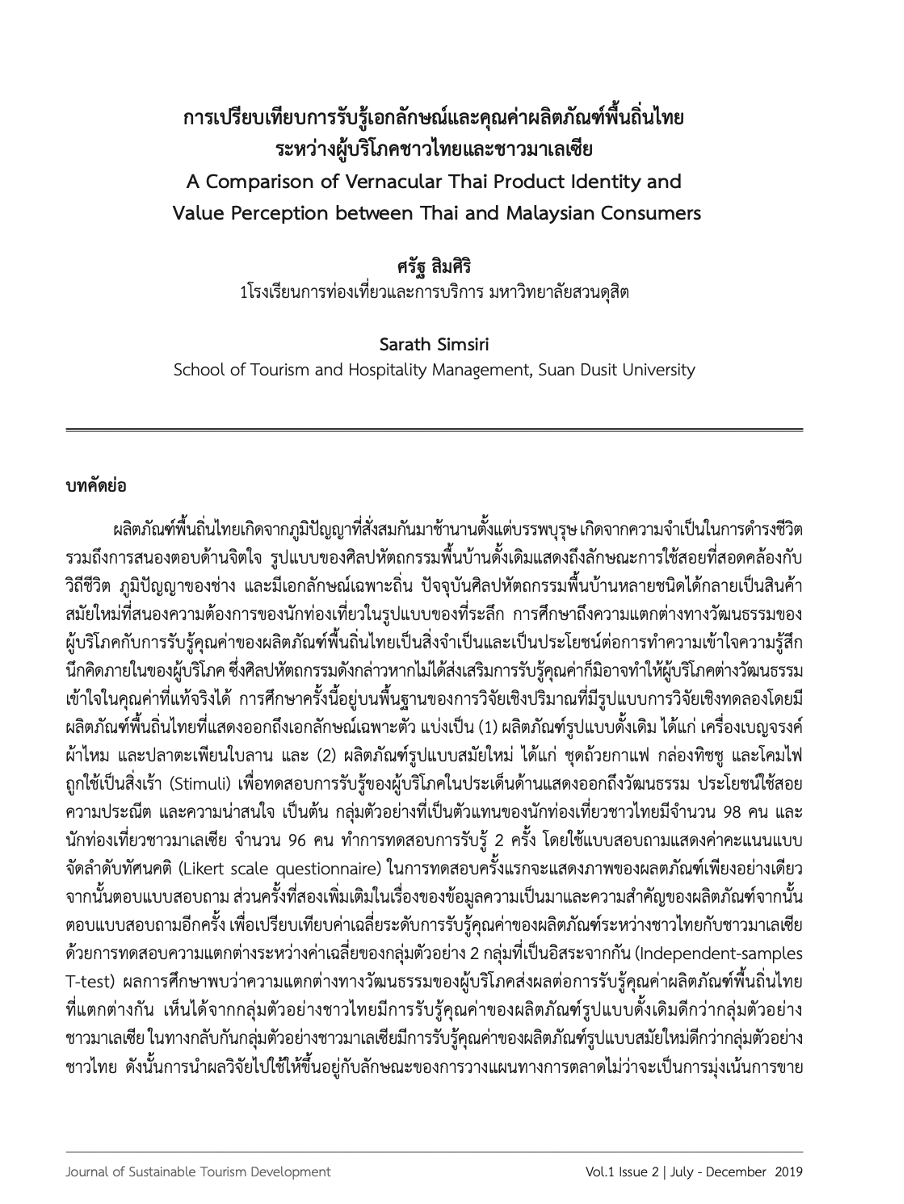การเปรียบเทียบการรับรู้เอกลักษณ์และคุณค่าผลิตภัณฑ์พื้นถิ่นไทย ระหว่างผู้บริโภคชาวไทยและชาวมาเลเซีย
Main Article Content
บทคัดย่อ
ผลิตภัณฑ์พื้นถิ่นไทยเกิดจากภูมิปัญญาที่สั่งสมกันมาช้านานตั้งแต่บรรพบุรุษ เกิดจากความจำเป็นในการดำรงชีวิตรวมถึงการสนองตอบด้านจิตใจ รูปแบบของศิลปหัตถกรรมพื้นบ้านดั้งเดิมแสดงถึงลักษณะการใช้สอยที่สอดคล้องกับวิถีชีวิต ภูมิปัญญาของช่าง และมีเอกลักษณ์เฉพาะถิ่น ปัจจุบันศิลปหัตถกรรมพื้นบ้านหลายชนิดได้กลายเป็นสินค้าสมัยใหม่ที่สนองความต้องการของนักท่องเที่ยวในรูปแบบของที่ระลึก การศึกษาถึงความแตกต่างทางวัฒนธรรมของผู้บริโภคกับการรับรู้คุณค่าของผลิตภัณฑ์พื้นถิ่นไทยเป็นสิ่งจำเป็นและเป็นประโยชน์ต่อการทำความเข้าใจความรู้สึกนึกคิดภายในของผู้บริโภค ซึ่งศิลปหัตถกรรมดังกล่าวหากไม่ได้ส่งเสริมการรับรู้คุณค่าก็มิอาจทำให้ผู้บริโภคต่างวัฒนธรรมเข้าใจในคุณค่าที่แท้จริงได้ การศึกษาครั้งนี้อยู่บนพื้นฐานของการวิจัยเชิงปริมาณที่มีรูปแบบการวิจัยเชิงทดลองโดยมีผลิตภัณฑ์พื้นถิ่นไทยที่แสดงออกถึงเอกลักษณ์เฉพาะตัว แบ่งเป็น (1) ผลิตภัณฑ์รูปแบบดั้งเดิม ได้แก่ เครื่องเบญจรงค์ ผ้าไหม และปลาตะเพียนใบลาน และ (2) ผลิตภัณฑ์รูปแบบสมัยใหม่ ได้แก่ ชุดถ้วยกาแฟ กล่องทิชชู และโคมไฟ ถูกใช้เป็นสิ่งเร้า (Stimuli) เพื่อทดสอบการรับรู้ของผู้บริโภคในประเด็นด้านแสดงออกถึงวัฒนธรรม ประโยชน์ใช้สอย ความประณีต และความน่าสนใจ เป็นต้น กลุ่มตัวอย่างที่เป็นตัวแทนของนักท่องเที่ยวชาวไทยมีจำนวน 98 คน และนักท่องเที่ยวชาวมาเลเซีย จำนวน 96 คน ทำการทดสอบการรับรู้ 2 ครั้ง โดยใช้แบบสอบถามแสดงค่าคะแนนแบบจัดลำดับทัศนคติ (Likert scale questionnaire) ในการทดสอบครั้งแรกจะแสดงภาพของผลตภัณฑ์เพียงอย่างเดียวจากนั้นตอบแบบสอบถาม ส่วนครั้งที่สองเพิ่มเติมในเรื่องของข้อมูลความเป็นมาและความสำคัญของผลิตภัณฑ์จากนั้นตอบแบบสอบถามอีกครั้ง เพื่อเปรียบเทียบค่าเฉลี่ยระดับการรับรู้คุณค่าของผลิตภัณฑ์ระหว่างชาวไทยกับชาวมาเลเซีย ด้วยการทดสอบความแตกต่างระหว่างค่าเฉลี่ยของกลุ่มตัวอย่าง 2 กลุ่มที่เป็นอิสระจากกัน (Independent-samples T-test) ผลการศึกษาพบว่าความแตกต่างทางวัฒนธรรมของผู้บริโภคส่งผลต่อการรับรู้คุณค่าผลิตภัณฑ์พื้นถิ่นไทยที่แตกต่างกัน เห็นได้จากกลุ่มตัวอย่างชาวไทยมีการรับรู้คุณค่าของผลิตภัณฑ์รูปแบบดั้งเดิมดีกว่ากลุ่มตัวอย่างชาวมาเลเซีย ในทางกลับกันกลุ่มตัวอย่างชาวมาเลเซียมีการรับรู้คุณค่าของผลิตภัณฑ์รูปแบบสมัยใหม่ดีกว่ากลุ่มตัวอย่างชาวไทย ดังนั้นการนำผลวิจัยไปใช้ให้ขึ้นอยู่กับลักษณะของการวางแผนทางการตลาดไม่ว่าจะเป็นการมุ่งเน้นการขายสินค้าให้กับผู้บริโภคชาวไทยเองหรือมุ่งเน้นเฉพาะตลาดผู้บริโภคต่างประเทศ อีกทั้งยังเป็นแนวทางในการจัดการข้อมูลสำคัญต่างๆของผลิตภัณฑ์ที่จะนำเสนอไปสู่ผู้บริโภคให้ตรงตามความต้องการและปรับระดับการรับรู้ ไม่ว่าจะด้วยวิธีการให้ข้อมูลโดยสื่อต่างๆ อาทิ จุดแสดงสินค้า แผ่นพับ ป้ายต่าง บรรจุภัณฑ์ หรือพนักงานขาย
Article Details

This work is licensed under a Creative Commons Attribution-NonCommercial-NoDerivatives 4.0 International License.
ลิขสิทธิ์ต้นฉบับที่ได้รับการตีพิมพ์ในวารสารเพื่อการพัฒนาการท่องเที่ยวสู่ความยั่งยืน ถือเป็นกรรมสิทธิ์ของโรงเรียนการท่องเที่ยวและการบริการ มหาวิทยาลัยสวนดุสิต ห้ามผู้ใดนำข้อความทั้งหมดหรือบางส่วนไปพิมพ์ซ้ำ เว้นแต่จะได้รับอนุญาตอย่างเป็นลายลักษณ์อักษรจากโรงเรียนการท่องเที่ยวและการบริการ มหาวิทยาลัยสวนดุสิต นอกจากนี้ เนื้อหาที่ปรากฎในบทความเป็นความรับผิดชอบของผู้เขียน ทั้งนี้ไม่รวมความผิดพลาดอันเกิดจากเทคนิคการพิมพ์
References
กรมการท่องเที่ยว. (2554). Summary of foreign tourists in 2011 and 2013. กระทรวงการท่องเที่ยวและกีฬา.
คุณนิออน สนิทวงศ์ ณ อยุธยา. (2551). ลักษณะไทย. Bangkok: Amarin Printing & Publishing.
พัชราภา เขียวขำ. (2546). Public Relations Strategy of Thailand's Brand Project. Department of Export Promotion: CUIR at Chulalongkorn University Thailand.
วิบูลย์ ลี้สุวรรณ. (2546). Folk Art. Bangkok: Amarin Printing & Publishing.
วิบูลย์ ลี้สุวรรณ. (2553). Folk Handicrafts: Local Identity. Silpakorn University: International Journal.
ศิริวรรณ เสรีรัตน์. (2541). Business research. Bangkok: Diamond in Business World.
แสงอรุณ รัตกสิกร และนิจ หิญชีระนันทน์. (2551). ลักษณะไทย. Bangkok: Amarin Printing & Publishing.
Aaker, J. L. (2000). Accessibility or Diagnosticity? Disentangling the Influence of Culture on Persuasion Processes and Attitudes. J Consum Res 26(4), 340–57.
Ahmed, Z. U. (1996). An International Marketing Perspective of Canadian Tourists’ Shopping Behavior: Minot (North Dakota). Journal of Vacation Marketing 2(3), 207-14.
Ahn, J. Y. and G. H. Jeong. (1996). Behavioral Characteristics of Korean Outbound Travel Market: Marketing Implications for Indo-China Tourism Industry. From Conference Proceedings of the ‘Tourism in Indo-China: Opportunities for Investment, Development and Marketing’ Conference, edited by K. Chon, 54-64. Houston: University of Houston.
Anderson, L. F. and M. A. Littrell. (1995). Souvenir-Purchase Behavior of Women Tourists. Annals of Tourism Research 22 (2), 328-48.
Anderson, L. F. and M. A. Littrell. (1996). Group Profiles of Women as Tourists and Purchasers of Souvenirs. Family and Consumer Sciences Research Journal 25: 28–56.
Aspelin, P. L. (1977). The Anthropological Analysis of Tourism: Indirect Tourism and Political Economy in the Case of the Mamainde of Mato Grosso, Brazil. Annals of Tourism Research 4 (2), 135-60.
Eagly, Alice H., and Shelly Chaiken. (1993). The Psychology of Attitudes. Fort Worth: Harcourt Brace Jovanovich.
Fairhurst, A., C. Costello, and A. F. Holmes. (2007). An Examination of Shopping Behavior of Visitors to Tennessee According to Tourist Typologies. Journal of Vacation Marketing 13 (4), 311-20.
Gordon, B. (1986). The Souvenir: Messenger of the Extraordinary. Journal of Popular Culture 20 (3), 135–46.
Graburn, N. (1977). Tourism: The Sacred Journey. In Host and Guest: The Anthropology of Tourism, edited by V. Smith, 17-31. Philadelphia: University of Pennsylvania Press.
Ho, M. C., C. H. Lin, and Y. C. Liu. (1996). Some Speculations on Developing Cultural Commodities. Journal of Design 1 (1), 1-15.
Hong, Yu and Mary Ann Littrell. (2005). Tourists' Shopping Orientations for Handcrafts. Journal of Travel & Tourism Marketing 18 (4), 1-19.
Hong, Yu and Mary Ann Littrell. (2003). Product and Process Orientations to Tourism Shopping. Journal of Travel Research 42: 141-3.
Junyean, Moon, Doren Chadee, and Surinder Tikoo. (2006). Culture, Product Type, and Price Influences on Consumer Purchase Intention to Buy Personalized Products Online. Journal of Business Research 61, 31–9.
Kim, S. and M. A. Littrell. (2001). Souvenir Buying Intentions for Self Versus Others. Annals of Tourism Research 28 (3), 638-57.
Lee, K. P. (2004). Design Methods for a Cross-Cultural Collaborative Design Project. In Proceedings of Design Research Society International Conference: Monash University.
Leong, D. and Clark, H. (2003). Culture-Based Knowledge Towards new Design Thinking and Practice - A Dialogue. Design Issues 19 (3), 48-58.
Lickorish and Jenkins (1997)
Lin, R. T. (2005). Creative Learning Model for Cross Cultural Product. Art Appreciation 1 (12), 52–59
Lin, R. T. (2007). Transforming Taiwan aboriginal cultural features into modern product design: A case study of a cross-cultural product design model. International Journal of Design 1 (2), 45-53.
Littrell, M. A. (1990). Symbolic Significance of Textiles Crafts for Tourists. Annals of Tourism Research 17, 228–45.
Littrell, M. A., S. Baizerman, R. Kean, S. Gahring, S. Niemeyer, R. Reilly, J. Stout. (1994). Souvenirs and Tourism Styles. Journal of Travel Research 33 (1), 3–11.
MacCannell, D. (1973). Authenticity: Arrangements of Social Space in Tourist Setting. Journal of Sociology 79 (3), 589–603.
Park, M. K. (2000). Social and Cultural Factors Influencing Tourists’ Souvenir-Purchasing Behavior: A Comparative Study on Japanese ‘Omiyage’ and Korean ‘Sunmul.’ Journal of Travel & Tourism Marketing 9 (1/2), 81-91.
Revilla, G., and T. H. Godd. (2003). Authenticity Perceptions of Talavera Pottery. Journal of Travel Research 42 (1), 94-9.
Revilla, G., and T. H. Godd. (2003). Authenticity Perceptions of Talavera Pottery. Journal of Travel Research 42 (1), 94-9.
Robert, G. Hershberger. (1970). Architecture and Meaning. Journal of Aesthetic Education, Special Issue: The Environment and the Aesthetic Quality of Life 4 (4), 37-55.
Takada, H, and D. Jain. (1991). Cross-National Analysis of Diffusion of Consumer Durable Goods in Pacific Rim Countries. J Mark 55 (2), 48–54.
Van-Nam Huynh, Hongbin Yan, and Yoshiteru Nakamori. (2010). A Target-Based Decision-Making Approach to Consumer-Oriented Evaluation Model for Japanese Traditional Crafts. IEEE Trans. Eng. Manag 57 (4).
Zaichkowsky, J. L. and J. H. Sood. (1989). A Global Look at Consumer Involvement and Use of Products. Int Mark Rev 6 (1), 20–35.
